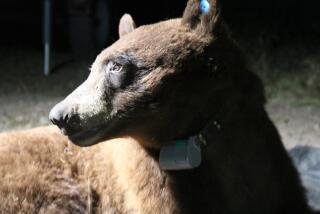Wild gray wolf still roaming California
The gray wolf that crossed into Northern California from Oregon just after Christmas looks to be sticking around for a bit. The lone male wolf has traveled more than 800 miles from a pack in Northeastern Oregon and is the first known wild wolf in California since the last one was killed by trapper in 1924.
Wednesday telemetry from a GPS collar put on the wolf last February still shows the 2½-year-old roaming Siskyou County, near the Oregon border.
“He is still in the state,” says Jordan Traverso, spokesperson for the California Department of Fish and Game. “We get updates sometimes a couple times a day, depending on atmospheric conditions.”
Because the wolf originated from Oregon and was collared there, he is known as OR-7. He is tracked by the Oregon Department of Fish and Wildlife, and that info is relayed to California authorities. Fish and Game officials do not want to disclose the exact location of the wolf to minimize the chance of any contact with humans.
“For the first few days, he was in northern Siskiyou County, but he was roaming around in a 10-mile radius. Now it looks like he’s expanding his radius, roaming with a 30-mile radius,” Traverso said.
A trail camera captured a photo of OR-7, our Christmas wolf, near Ashland, Ore., in late December. That photo appeared in the Ashland Daily Tidings on Wednesday.
OR-7 set out from Oregon’s Imnaha pack around Sept. 10 in what is described as very typical dispersal behavior for a lone male wolf. Wolves will leave a pack looking for a new mate, searching for new food sources, or looking to start or join a new pack elsewhere. There are no other known wolves in Northern California, but it is not out of the question that other, untracked wolves might have traveled there.
California does not currently manage wolves, and the DFG is not yet set up to do so. Traverso acknowledges that, if he stays, there’s work to do.
“We have to figure out what he’s going to do to first. It would be a little early to say we’re going to have a study group when we don’t know what’s going to happen yet. In the event that wolves do repopulate here, we’ll have to manage them,” she says.
Right now, she adds, DFG officials are being educated about wolves, a dialogue is continuing with the Oregon tracking station, and management issues are being discussed. Info is available on the department website.
And California feels a little more wild.
RELATED:
Call safe-sex hotline, save endangered species
FBI tracking videotapers as terrorists?
Oil more toxic than previously thought






